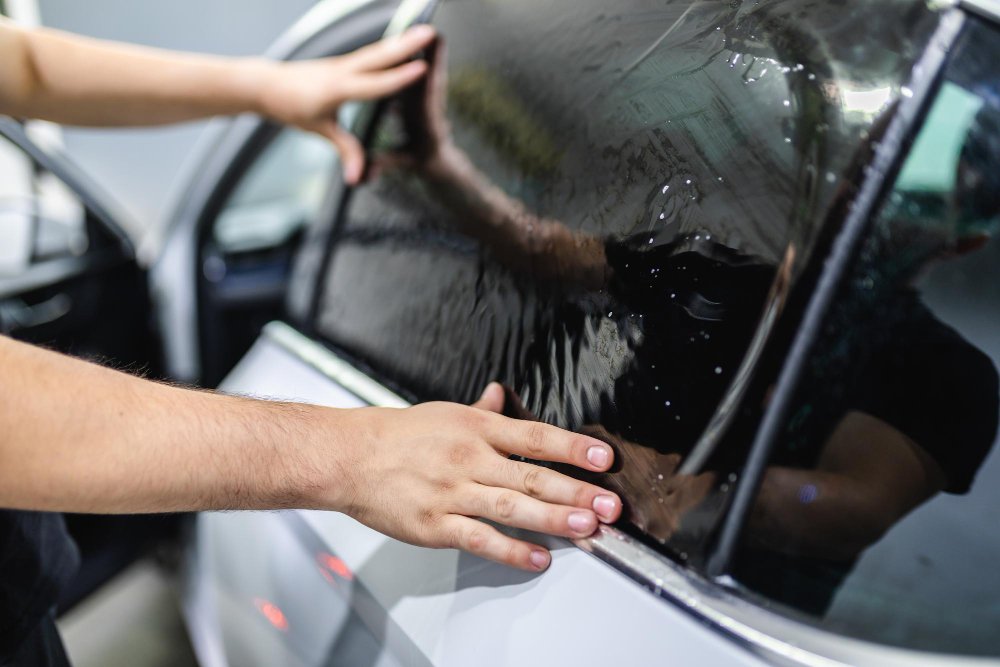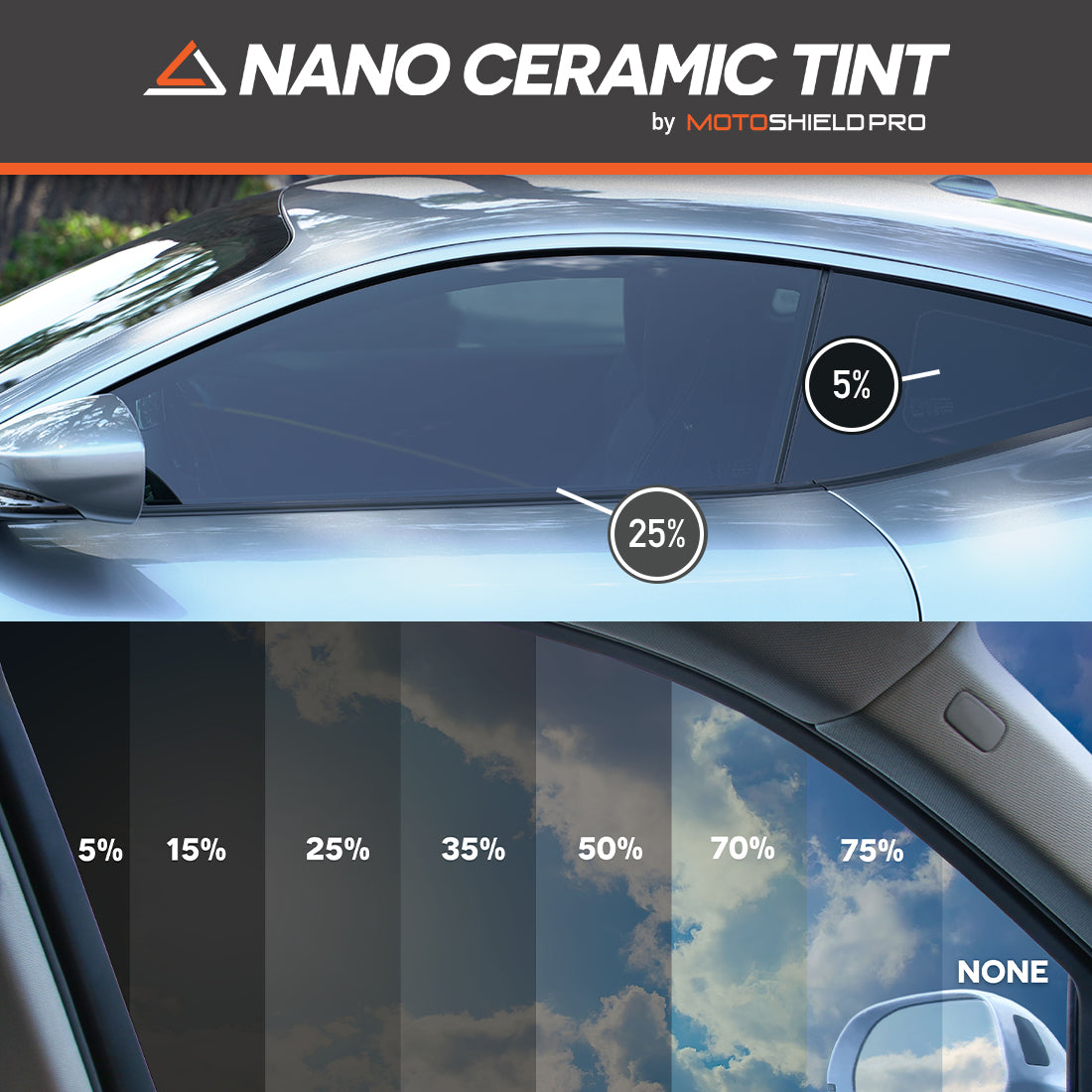The Benefits of Selecting Davinci of Michigan for Automotive Tinting
Wiki Article
A Comprehensive Guide to Comprehending Car Home Window Color and Its Advantages
Automobile window tinting offers more than just an aesthetic objective for vehicles. It offers different kinds, each with distinct functions and advantages. Understanding these choices, in addition to legal regulations and upkeep ideas, is essential for any lorry owner. The benefits may greatly enhance driving comfort and car durability. As one checks out the nuances of window tinting, the question develops: what sort of color is finest suited for private demands?Comprehending Auto Window Tint: What It Is and Just how It Functions
Car window color serves as a safety barrier that improves lorry aesthetics while providing functional benefits. This slim movie is put on the indoor surface of cars and truck windows, decreasing glow and obstructing harmful ultraviolet (UV) rays from the sun. By filtering system sunlight, vehicle home window tint helps to control the interior temperature of the lorry, resulting in boosted comfort for travelers and minimized dependence on air conditioning.Additionally, it protects the automobile's interior from fading, maintaining both upholstery and control panel materials. The color can additionally improve personal privacy, making it harder for outsiders to see inside the lorry. In addition, specific types of home window tint can raise safety and security; in the occasion of an accident, the movie assists hold destroyed glass together, reducing the danger of injury from flying shards. Generally, car home window color offers both functional and visual purposes, making it a popular selection among vehicle owners.Kinds Of Home Window Tint: An Introduction of Options
When considering home window tint choices, several types are readily available, each with distinct characteristics. Dyed, metalized, and ceramic home window tints provide differing degrees of heat being rejected, UV defense, and aesthetic allure. Understanding these differences can help car owners make educated options based upon their needs and choices.Colored Window Color
Colored window color stands for a popular option among car proprietors looking for a budget friendly and reliable means to boost their lorry's aesthetics and privacy. This type of color is developed by putting a layer of color between an adhesive layer and a protective covering, leading to a darkened look that lowers glare and enhances aesthetic convenience. While dyed window color properly obstructs harmful UV rays, it may not offer the exact same degree of warmth being rejected as various other color types. In addition, its color can discolor with time, potentially diminishing its performance. In spite of these disadvantages, dyed window tint stays favored for its cost-effectiveness and ability to give a smooth, stylish aim to various lorry versions.Metalized Window Color
Metalized window color uses a balance of style and functionality, making it a preferred selection among vehicle owners. This sort of color includes metal particles within the movie, enhancing both aesthetic allure and heat rejection. The reflective high quality of metalized color helps to lower glow and improve personal privacy, while additionally providing UV security, which safeguards the automobile's interior. Additionally, metalized window color can strengthen home window stamina, possibly stopping shattering throughout crashes. However, it is important to keep in mind that the metal components can hinder electronic signals, such as general practitioner and cellular phone function. In general, metalized window tint supplies a reliable service for those seeking a combination of appearance, durability, and sun security for their automobiles.
Ceramic Home Window Tint
Ceramic home window tint represents an innovative alternative in the spectrum of automobile window films, using distinct advantages over standard colors. Unlike dyed or metalized movies, ceramic colors utilize sophisticated ceramic fragments, which properly deny warm and UV rays without jeopardizing presence. This technology ensures that vehicles stay cooler, minimizing reliance on cooling and boosting gas performance. Additionally, ceramic home window tints are less most likely to interfere with electronic gadgets, such as general practitioner or mobile signals, making them a sensible choice for modern cars. In addition, their longevity and scratch resistance add to a longer life-span contrasted to various other kinds of tints. In general, ceramic window tint supplies remarkable performance, convenience, and defense, making it a preferred alternative for discerning vehicle owners.Benefits of Automobile Home Window Color: Beyond Visual Appeals
While many individuals associate car window tint with enhanced design, its advantages prolong much beyond mere visual appeals. One significant benefit is warmth decrease; window color can block approximately 99% of damaging UV rays, protecting and maintaining the interior colder furniture from fading. This not just improves comfort throughout warm climate however likewise reduces dependence on air conditioning, bring about boosted fuel efficiency.In addition, vehicle window color gives an added layer of personal privacy and safety and security. Colored windows make it difficult find here for outsiders to see inside the car, which can hinder burglary and safeguard valuables. In addition, lots of tints strengthen the glass, lowering the likelihood of ruining in case of a crash, thus improving safety.In enhancement to these functional advantages, auto home window tint can additionally contribute to glare reduction, enhancing visibility for drivers and Check This Out passengers alike. This complex technique to convenience and safety and security makes home window tint a useful financial investment for car owners.Lawful Considerations: Tinting Laws by State
Prior to devoting to vehicle window color, car proprietors need to navigate a complex landscape of tinting guidelines that differ by state. Each state has details regulations regulating the acceptable levels of color darkness and reflectivity for various windows, including windscreens, front side windows, and rear home windows. These policies typically consist of visible light transmission (VLT) portions, which determine exactly how much light can travel through the colored glass.Some states permit darker tints on rear home windows while restricting front side and windscreen colors for security factors. In addition, particular states might require a certification from the supplier to validate compliance with tinting legislations. Violating these guidelines can result in penalties, necessary removal of the color, or both. Consequently, it is important for car owners to investigate their state's regulations extensively to ensure legal compliance before installing home window tint. This persistance can conserve time and money over time.Selecting the Right Tint: Elements to Think about
When choosing the appropriate home window tint for an automobile, numerous vital variables enter into play. Tint darkness levels, UV protection rankings, and conformity with lawful regulations are essential considerations to ensure both appearances and capability. Examining these facets will help individuals make an educated choice that satisfies their requirements and complies with regional legislations.Color Darkness Degrees
Selecting the proper color darkness level is important for achieving the desired equilibrium in between visual appeals and performance in auto window tinting. Various states have varying legal guidelines concerning color darkness, which can influence the choice. Generally, colors are measured in percents, with reduced percents showing darker tones. Darker tints supply raised personal privacy and a sleek look click over here however can minimize presence, particularly during the night. Alternatively, lighter tints keep an even more open feel, ensuring ample visibility while still giving some warmth and glare decrease. When making a choice, individuals must consider their driving practices, regional laws, and personal preferences. Eventually, the best tint darkness level enhances the car's appearance while guaranteeing safety and compliance with legal criteria.UV Protection Rating
Color darkness levels play a significant duty in the overall performance of automobile window tinting, however another essential variable to review is the UV protection ranking of the selected tint. This rating shows the percent of unsafe ultraviolet rays that the color can obstruct. High-quality colors often offer 99% or more UV protection, securing guests and the car's interior from sunlight damage. Davinci of Michigan. Prolonged exposure to UV rays can bring about skin troubles and fading of upholstery, making a high UV defense ranking crucial for health and durability. When picking window color, consumers ought to prioritize this ranking together with darkness levels to assure optimum convenience and security while driving. Understanding these factors aids in making an educated decision when buying auto home window tintingLawful Laws Compliance
Recognizing neighborhood legal policies is essential for any individual taking into consideration vehicle window tinting. Each state or area has certain laws governing the allowed levels of color darkness and reflectivity for different home windows. These policies typically specify the visible light transmission percentage, identifying how much light can go through the tinted glass. Non-compliance can lead to penalties, mandatory elimination of the color, or concerns throughout lorry assessments. In addition, some locations may have constraints on making use of particular tinting materials, needing consumers to pick items that meet safety and security requirements. It is important for vehicle owners to investigate their neighborhood laws completely prior to selecting window color to assure compliance and prevent possible legal complications.
Setup Process: do it yourself vs. Professional Services
Exactly how does one choose between a DIY installment and working with specialist solutions for vehicle home window tinting? The option usually pivots on budget, experience, and preferred results. A DIY technique can be cost-effective, enabling individuals to reduce labor costs. Nonetheless, it calls for a specific degree of ability and knowledge concerning the tinting process. Those who are thorough and client might locate success with DIY sets available in the market.Conversely, specialist solutions supply experience and high-grade materials, making certain a perfect surface. Specialists frequently assure their job, offering satisfaction versus possible issues such as peeling or gurgling. In addition, they are familiar with regional regulations pertaining to tinting, which can be complicated for the ordinary car owner.Ultimately, the decision reflects a balance between cost, personal ability, and the anticipated high quality of the tinting job. Each option has its advantages, and the very best choice depends on individual situations and preferences.Upkeep Tips: Maintaining Your Tint in Top Condition

Often Asked Inquiries
For How Long Does Window Color Generally Last on a Car?
Window tint commonly lasts in between five to 10 years, depending upon elements such as top quality, application, and environmental problems. Regular upkeep and correct treatment can prolong its lifespan, ensuring suitable performance and look over time.Can Window Tinting Damages My Automobile's Original Glass?
Home window tinting, when applied appropriately, does not harm an auto's initial glass. Incorrect installation or low-grade products might lead to concerns like peeling or gurgling, possibly influencing the glass's integrity over time.Is Window Tinting Safe for All Types of Automobiles?
Window tinting is normally safe for a lot of lorries, offered the film adheres to regional guidelines and is correctly applied. Some specific vehicles may require certain considerations, making it vital to speak with professionals prior to installment.Will Home Window Tinting Void My Cars And Truck Guarantee?
The concern of whether home window tinting spaces a car guarantee often depends upon the producer's policies. Typically, if the tint does not harm the automobile, guarantees usually stay intact. However, seeking advice from the dealer is suggested.Can I Remove Home Window Tint Myself if Needed?
Getting rid of window tint oneself is feasible, but it calls for mindful attention to prevent damaging the glass. People should use suitable devices and methods to ensure a successful removal without leaving sticky deposit or scrapes behind. While colored home window color successfully blocks hazardous UV rays, it may not supply the very same degree of heat rejection as other color types. Ceramic window tint stands for an advanced alternative in the spectrum of vehicle home window films, using distinctive advantages over standard tints. Prior to dedicating to automobile window tint, lorry proprietors must browse a complicated landscape of tinting laws that vary by state. These policies frequently consist of noticeable light transmission (VLT) percents, which determine how much light can pass through the tinted glass.Some states permit darker colors on back home windows while restricting front side and windshield tints for safety reasons. Color darkness levels play a considerable function in the overall performance of car window tinting, yet an additional essential element to evaluate is the UV security rating of the picked color.Report this wiki page